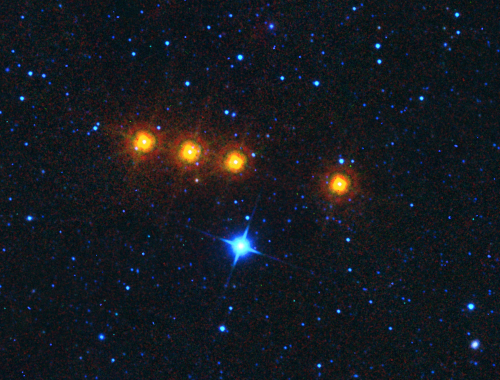
Time-lapse image of the asteroid Euphrosyne as seen by NASA’s WISE space telescope, which is used by NEOWISE to measure asteroid sizes. (Courtesy: NASA)
By Hamish Johnston
First-up in this week’s Red Folder is a tale of killer asteroids, hubris and peer review from the Washington Post. The science writer Rachel Feltman has written a nice article about a claim by physicist-turned-entrepreneur Nathan Myhrvold that NASA’s research on asteroids that could potentially collide with Earth is deeply flawed. On Monday, Myhrvold posted a 111-page preprint on arXiv that argues that asteroid radii measured by NASA’s NEOWISE project are far less accurate than stated by NASA scientists. What’s more, Myhrvold seems to suggest that NEOWISE scientists have “copied” some results from previous asteroid studies.
Myhrvold began his career as a theoretical physicist and, after a stint as Microsoft’s chief technology officer, founded an intellectual-property firm. He has never worked in the field of asteroids, yet he has taken great exception to some of the physics and statistical analysis underlying the NEOWISE results. His paper has been submitted to the journal Icarus, but has not yet passed peer review – unlike the NEOWISE results. In her article, Feltman ponders why Myhrvold is actively promoting his controversial work – he was featured in a New York Times article on Monday – before it has passed peer review. She also speaks to several NEOWISE scientists, who are not amused.
In 2011 Myhrvold published an extravagant cookbook titled Modernist Cuisine, which applies the latest science and technology to cooking. Over at the Guardian, the anaesthetist and television baker Tamal Ray “takes us on a tour of gastrophysics” in three short videos. The physics is spread very thin, but it’s an interesting take on how physical properties such as colour and texture affect our perception of how food tastes.
It’s always nice to hear about physicists who use their analytical skills for the greater good. The latest to come across our radar is Andrei Rostovtsev, who co-founded Dissernet, which is an organization that combats the growing trend in Russia for plagiarized PhD dissertations. Rostovtsev has developed software that scans text from dissertations deposited in the Russian State Library and compares the prose with other works. If significant matches are found, the dissertation is then examined by one of Dissernet’s volunteers.
Sometimes the plagiarized work isn’t produced by the doctoral candidate, but rather by a professional ghost writer. This is a growing problem in Russia, according to an article in Slate by Leon Neyfakh entitled “The Craziest Black Market in Russia”. Neyfakh says that the rich and powerful in Russia seem to crave the intellectual kudos of having a PhD – but believe it or not, some oligarchs haven’t spent bleary-eyed nights writing their own dissertations.
Debunking bogus dissertations is one of many things you can do with a physics background. #IAmAPhysicist on Twitter is a great place to rejoice in the amazing diversity of people who call themselves physicists – and the wide range of jobs that they do.
With the easy accessibility of large and wide range of information, the “paid plagiarisation” for any subject or theme has started to thrive everywhere